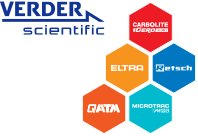Representative sample preparation, heat treatment and accurate analysis (e.g., element concentrations, hardness, particle size and shape) of raw materials, intermediate and finished products are important steps of quality control in the coal industry. VERDER SCIENTIFIC sets standards in high-tech equipment for quality control, research and development. The Verder Scientific brands have served research institutions and analytical laboratories, as well as manufacturing companies in quality control and process applications, for many decades with sophisticated and reliable products.
No Records Found
Sorry, no records were found. Please adjust your search criteria and try again.






